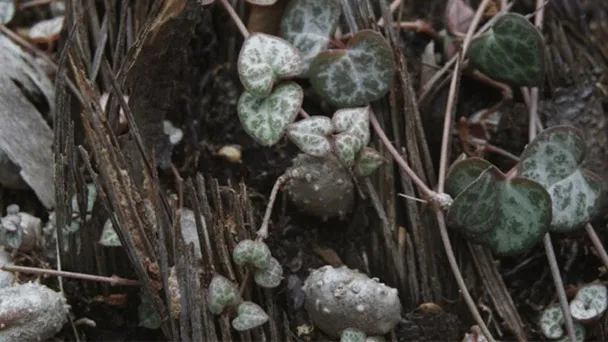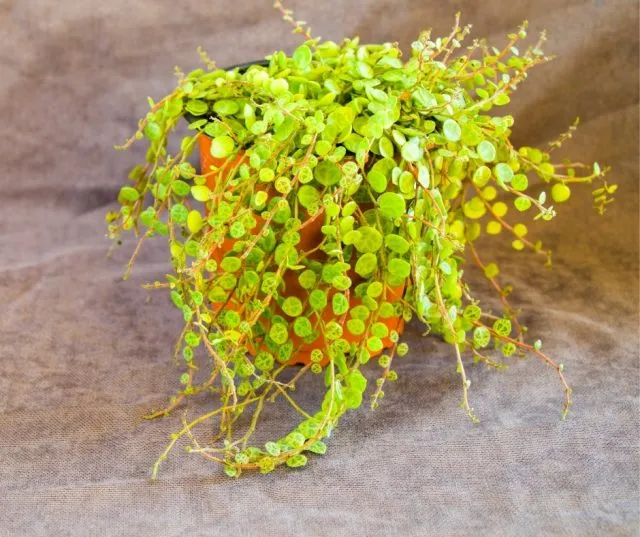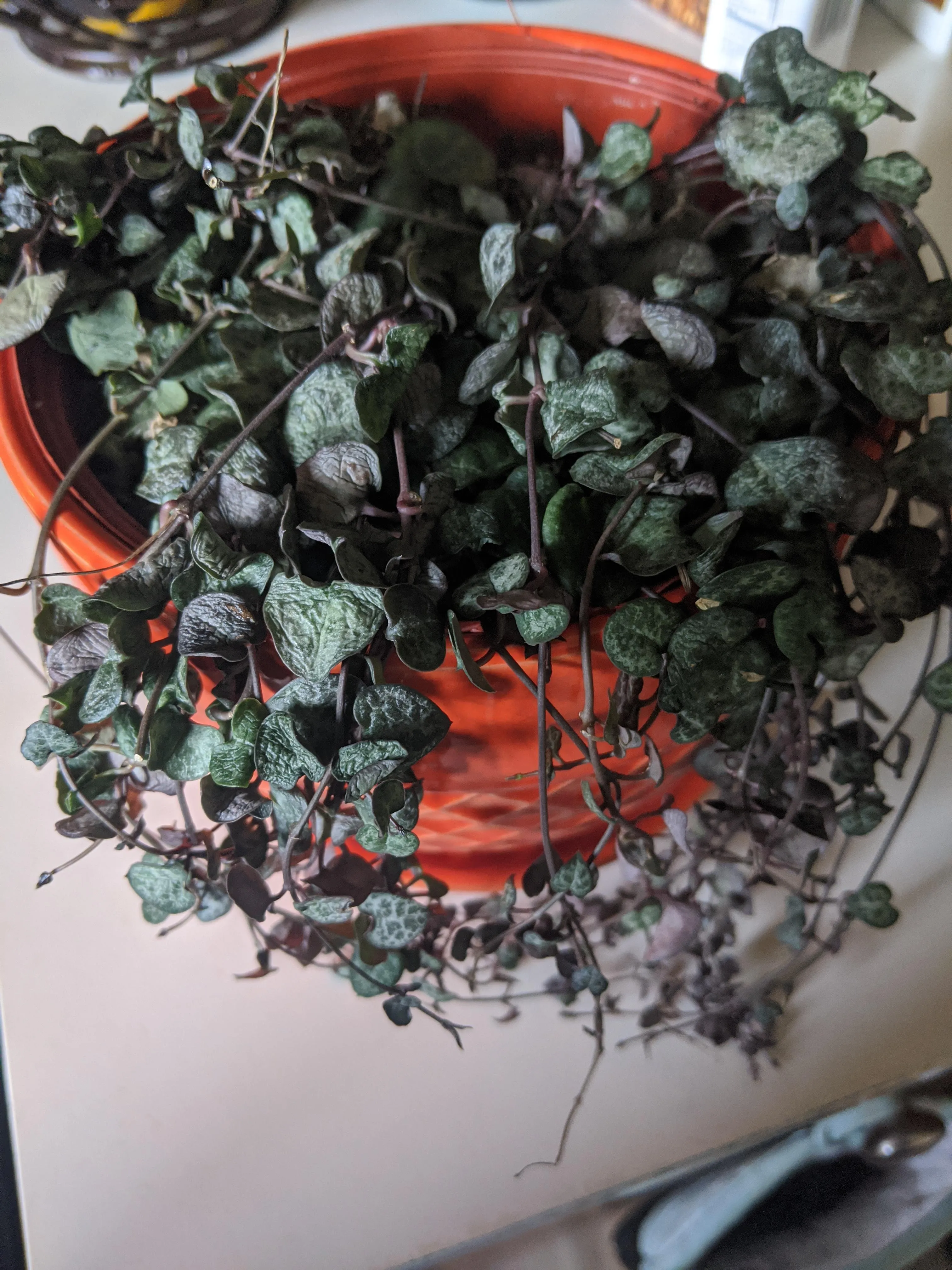Why My String of Hearts Have Wrinkled Leaves
Written by Ivy
Jan 20 2023

String of hearts is a succulent plant of the genus chandelier of Asclepiadaceae, also known as a succulent plant. String of hearts can be hung from a high place. Because its leaves are beautiful in shape and color, it is of great ornamental value to plant at home. It can also prevent radiation and purify the air. However, string of hearts propagation requires methods. Improper caring will affect the development of string of hearts leaves. What should we do if the string of hearts leaves are wrinkled? Let's have a look.

Read More: How to Save Overwatered String of Hearts Plant
Moreover, the metabolic waste of string of hearts is also discharged through the small hole at the bottom of the flowerpot. If there is no small hole, these wastes cannot be set aside with watering, and excessive accumulation will also lead to rotten roots. (Also Read: How to Repot a String Of Hearts)
The growth of string of hearts roots requires not only water, but also a certain amount of oxygen for breathing. Moreover, normal growth will also make a stable proportion of water, air and minerals in the basin soil.
Read More:
String of Hearts Leaves Curling due to Drought StressHeat StressDrainage ProblemsImproper Humidity & VentilationRoot RotLack of LightFertilizerHow to Revive String of Hearts Curling up LeavesReduce the wateringReplace your soilUse a pot with drainage holesUse saucers and trays underneathString of Hearts Wrinkled Leaves FAQsHow much sunlight is required?Winter dormancy requirementsSoil & fertilizationIdeal watering frequency
String of Hearts Leaves Curling due to Drought Stress
Heat Stress
We should plant string of hearts in the astigmatism area for maintenance to avoid direct light. Especially in summer, heat stress is easy to burn the leaf surface, resulting in wrinkle of string of hearts leaves. In spring, autumn and winter, string of hearts can see about two hours of morning light every day, and astigmatism in summer.
Drainage Problems
String of hearts is very drought resistant and afraid of too much water. If the soil drainage of string of hearts is not good, it may lead to string of hearts. Usually, we need to add more sandy soil to the soil for cultivating string of hearts. After adding some coconut brown skin to the bottom of the basin, we can add some loose and well drained sandy soil. Two or three equal parts of granular soil should be mixed into the soil to ensure good air permeability and drainage.Improper Humidity & Ventilation
String of hearts has strong water storage capacity, and its rhizomes and leaves can store water. Therefore, in daily nursing, we can't keep string of hearts in a humid and airless environment, otherwise the rhizomes will rot and the leaves of string of hearts will dry due to insufficient nutrition. Therefore, we should strictly control the watering times of string of hearts and wait until the basin dries up before watering. In winter, string of hearts will enter the dormant state, so it should be watered less.Root Rot
The root block of string of hearts is large, which can store a lot of water and has strong drought tolerance. Do not water too often during management, otherwise it will not be absorbed, which will easily lead to ponding, retting roots, and the leaves at the root of string of hearts will wither and fall first. In this case, we should reduce watering, more ventilation and evaporate water. If the situation of string of hearts is serious, we should remove the pots, take out the plants, trim the rotten roots and then manage again.Read More: How to Save Overwatered String of Hearts Plant
Lack of Light
The suitable temperature for the growth of string of hearts is 15 ° - 25 °, so string of hearts grows vigorously in spring and summer. If it is winter, the indoor temperature should not be lower than 10 °, otherwise the leaves will be frostbitten and curled. Of course, we can't often change the growth environment for string of hearts, otherwise it will affect the growth of plants. String of hearts likes scattered light and doesn't like direct sunlight, so in summer, don't put the love vine outdoors, otherwise the leaves will be dehydrated due to too strong ultraviolet rays, resulting in wrinkle of string of hearts leaves. Therefore, in terms of light, it can be illuminated for two hours a day in spring, autumn and winter, and astigmatism in summer. If the maintenance environment is overcast for a long time and the light is insufficient, the growth of string of hearts leaves will be distorted and the ornamental value will be lost.Fertilizer
Hearts leaves needs topdressing during growth, but the amount and concentration of fertilizer must be controlled during topdressing. Large amount or high concentration will burn roots, and leaves are easy to wither. We should apply less fertilizer to make up fertilizer. If the fertilizer damage is serious, we should also remove the pot and prune the roots. We can plant in the pot again after changing the soil in hearts leaves.How to Revive String of Hearts Curling up Leaves
Reduce the watering
If the string of hearts leaves curl due to excessive watering, we can reduce the number of watering. String of hearts grows in different seasons, and the frequency of watering is also different. If there is a lot of water demand in spring and summer, it can be watered a little more frequently. It can be watered once every 1-3 days. In autumn, it is necessary to properly reduce water. With the continuous reduction of temperature, the watering times should be gradually reduced. In winter, it can be watered once every two weeks. If the temperature is too low, we can water the string of hearts once a month or 20 days.Read More:
Replace your soil
If your string of hearts leaves curl due to soil, we can change the pot. We can mix garden soil, rotten leaf soil and coal ash to prepare the replaced soil. When changing the pot of string of hearts, we should leave half of the old soil. When loading the soil, we can leave a third of the gap on the surface of the flower pot, so that the love vine can better adapt to the new soil. When changing the soil of string of hearts, we should pay attention not to hurt the root system of the plant, and we must start gently.Use a pot with drainage holes
The container we use to raise string of hearts must have small holes at the bottom. If the bottom of the string of hearts basin is watertight and breathable, water will accumulate if we pour some water casually, and the flowers are easy to rot. therefore, we can reduce the curl of string of hearts leaves through use a pot with drainage holes.Moreover, the metabolic waste of string of hearts is also discharged through the small hole at the bottom of the flowerpot. If there is no small hole, these wastes cannot be set aside with watering, and excessive accumulation will also lead to rotten roots. (Also Read: How to Repot a String Of Hearts)
The growth of string of hearts roots requires not only water, but also a certain amount of oxygen for breathing. Moreover, normal growth will also make a stable proportion of water, air and minerals in the basin soil.

Use saucers and trays underneath
There is a hole in the middle of the bottom of the string of hearts basin, which is used for air and water permeability, so as not to make the curly leaves and roots of string of hearts rot and die. The use of saucers and trays underneath is to catch the water leaked from the basin. If we maintain string of hearts indoors, considering the hygiene problem, we'd better use the tray, and after each watering, we should pour out the accumulated water in the tray in time, and never let the accumulated water stay overnight.String of Hearts Wrinkled Leaves FAQs
How much sunlight is required?
String of hearts itself does not require much light, and it can grow well in semi shade environment. However, if it is maintained in a dark room for a long time, it is easy to have excessive branches and leaves, thin stems and vines, thin leaves and light color due to lack of light, so as to reduce the ornamental effect. At this time, we can increase the light appropriately, String of hearts can be placed in a bright place indoors, and try to let it bask in the sun as much as possible.Winter dormancy requirements
String of hearts likes warmth and is afraid of cold and has poor cold resistance. If the temperature is lower than 8 ℃ for a long time in winter, string of hearts is prone to leaf loss and wilting; If the temperature is lower than 0 ~ 5 ℃ for a long time, string of hearts is prone to cold damage, frostbite the roots and leaves of the plant, and in serious cases, it may also lead to the death of the whole plant; Therefore, when curing string of hearts in winter, pay attention to heat preservation and antifreeze, move it to a warm room for maintenance in time, and keep the room temperature above 10 ° C as far as possible; If the room temperature is not so high, wrap the flowerpot with old clothes or cotton cloth, and cover a large plastic bag above the plant to achieve the effect of heat preservation and wind prevention. Take down the bag for ventilation when the weather is warm.Soil & fertilization
String of hearts itself does not have a high demand for fertilizer and water. It likes thin fertilizer solution. During the vigorous growth period, we can apply thin nitrogen, phosphorus and potassium compound liquid fertilizer every 15 ~ 20 days to supplement nutrients and promote brighter leaves and stronger growth. However, in winter, due to its slow growth and metabolism or even stagnation, the demand for fertilizer and water is almost zero, so fertilization is generally not recommended. Especially if the temperature at home is lower than 15 ℃, it is best to stop all fertilization to avoid fertilizer damage caused by low temperature, curling and even death of string of hearts leaves.Ideal watering frequency
String of hearts is resistant to drought and is afraid of waterlogging. The principle of seeing dry and seeing wet can be followed for watering at ordinary times, so as to keep the basin soil in a slightly wet state without ponding as far as possible; After winter, because the growth activity of string of hearts is not high and the demand for water is reduced, we can properly control the watering at this time. When we see that the surface of the basin soil becomes dry, we can water it once in time. Avoid long-term ponding in the basin to avoid root rot caused by too humidity.Read More:
Latest Updated
- Benefits of Bugleweed - 7 Science-backed Health Benefits
- Bugleweed Dangers & Side Effects - Is It Poisonous?
- How to Plant Evergreen Trees - What You Should Know
- When to Plant Evergreens - Grow Guide for Evergreen Trees
- 12 Wonderful Evergreen Shrubs for Your Garden
- 12 Popular Evergreen Plants with Pictures for Beginners
- When And How To Prune A Lilac Bush Like a Pro
- How to Grow & Care for Lilac Vine (Hardenbergia Violacea)
- Japanese Lilac Tree (Syringa Reticulata) Care & Propagation Guide
- Shumard Oak Pros and Cons - What to Know
Popular Articles
- Winter maintenance of Antirrhinum Majus
- How to Grow Terminalia Mantaly Tree
- How to Grow and Care for Crossostephium Chinense
- How to grow Antirrhinum Majus in spring
- Peristeria Elata (Dove Orchid) Profile: Info & Care Guide
- Underwatered Snake Plant (Sansevieria Trifasciata) - Signs And How To Fix
- How to Care for Brazilian Jasmine Plant (Mandevilla Sanderi)
- How to Grow & Care for Graptopetalum Purple Delight in Summer
- Rosa Chinensis (China Rose): Plant Growing & Care Tips
- How to Care for Baby Sun Rose (Aptenia Cordifolia)